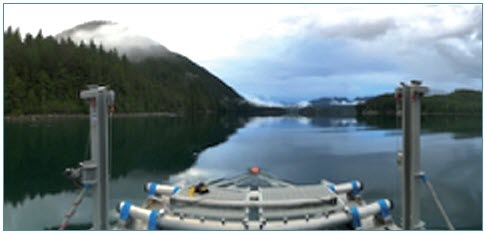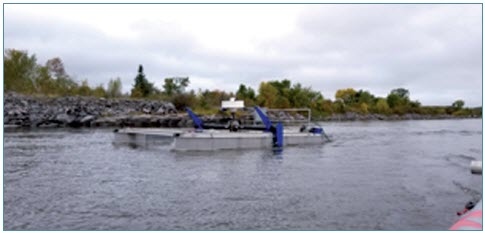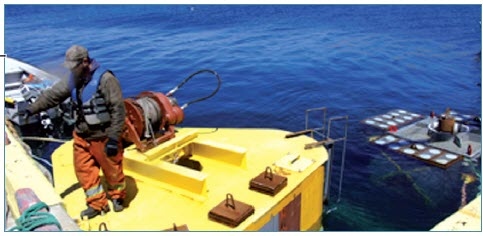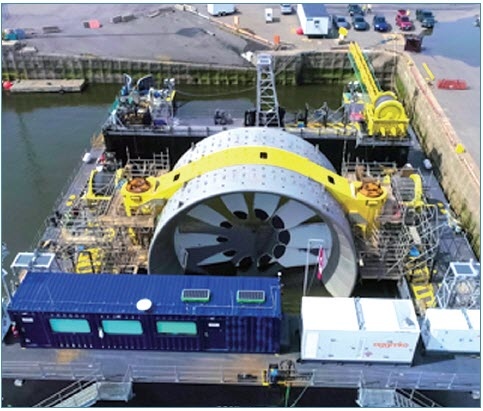CANADA
OPEN SEA TEST SITES
Canada has wave, tidal, and river current energy resources spanning the country. As a result of the opportunities presented by developing these resources, there are test sites available to support research and development of each marine renewable energy technology:
TIDAL CURRENT TURBINE TEST SITE
The Fundy Ocean Research Center for Energy (FORCE) is Canada’s leading research center for in-stream tidal energy, located in the Bay of Fundy, Nova Scotia. FORCE works with developers, regulators, and researchers to study the potential for tidal turbines to operate within the Bay of Fundy. As part of its mandate, FORCE has undergone baseline environmental studies, environmental effects monitoring, and applied research since 2009. In addition, FORCE created the Fundy Advanced Sensor Technology (FAST) program to advance efforts to monitor and characterize the FORCE site and improve marine operating methodologies to support research and turbine-related operations.
FORCE hosts five technology developers at its site and provides subsea and onshore electrical infrastructure to deliver power to the grid. The five developers have been awarded and have received feed-in tariff approvals from the Province of Nova Scotia, totaling 22 MW to be developed at the FORCE test site. In 2017, Cape Sharp Tidal successfully disconnected and recovered its 2 MW OpenHydro turbine from the FORCE site. This was the first grid-connected tidal turbine to operate at the FORCE site. Cape Sharp is currently inspecting and upgrading the turbine and intends to redeploy in 2018. Other developers scheduled for testing at the FORCE site include Minas Tidal, Black Rock Tidal Power, Atlantis Operations Canada, and Halagonia Tidal Energy (DP Energy).
RIVER HYDROKINETIC TURBINE TEST SITE
The Canadian Hydrokinetic Turbine Test Centre (CHTTC) in Manitoba allows turbine developers to test turbine prototypes and increase their technology readiness level. In 2017, CHTTC tested and connected the redesigned New Energy Corporation’s 25 kW device to the Manitoba Hydro grid in preparation for deployment at Sagkeeng First Nation. The project experienced delays due to certification issues for the marine power cable and the low frequency power electronics. CHTTC also conducted long-term flow measurements and improved on the filtering of ADV data to characterize energetic river flows. Support was also provided to companies developing marine turbines. As an important step to develop a Canadian resource map of potential energetic sites near remote communities reliant on diesel, in collaboration with NRCan, CHTTC used RadarSat II to capture radar images of four Indigenous communities. An autonomous data acquisition system funded by NRCan was developed to remotely monitor the 25 kW New Energy turbine powered by the turbine and solar panels.
|
WAVE ENERGY CONVERTER TEST SITE The College of the North Atlantic (CNA) operates the Wave Environment Research Centre (WERC) in Lord’s Cove on the south coast of the island of Newfoundland. The Centre was established to conduct research in the development of a wave-powered water pump coupled to a novel shore-based aquaculture system. Currently, there are six fully permitted mooring sites (at depths of 6 to 30 m) available within 1.5 km from shore. The site has collected more than three years of weather and wave environment data. In 2017, WERC conducted sea trials of its wave pump, a device intended to provide a flow of sea water to an onshore aquaculture farm. Over the last 6 years of developing the project, it has engaged over 200 college and university students and over 20 scientists, technicians and faculty. WERC recently upgraded its wave measurement capability with a second Nortec AWAC and telemetry system, while Rutter Inc. has deployed extensive radar-based wave measurements at the site. Atmocean, a US-based wave energy developer, deployed its wave powered pump at WERC for a month of preliminary testing, and NRG Systems is currently evaluating the marine durability of several of its meteorological sensors. |
|
OPERATIONAL PROJECTS
The 20 MW Annapolis Royal tidal barrage power plant was commissioned in 1984 and continues to operate today. It is owned and operated by Nova Scotia Power (a subsidiary of the utility company EMERA). Annapolis Royal is the only commercial tidal power plant in North America.
|
Cape Sharp Tidal installed the first of their two turbines into the Minas Passage at the FORCE site in Nova Scotia in 2016, resulting in $33 million of investment in the local supply chain during building and installation phases. The turbine was retrieved in June 2017 to allow for upgrades to its turbine control center (TCC). This was the first time OpenHydro’s pioneering TCC technology has been used anywhere in the world, an important step in advancing the ability to generate electricity from multiple turbines at sea and export to shore via a single export cable. Plans are underway for Cape Sharp’s next deployment and a demonstration array of two interconnected 2 MW turbines. Since the turbine deployment, Cape Sharp and FORCE have issued three environmental monitoring reports based on their Environmental Effects Monitoring Programs (EEMP). |
|
|
| Mavi Innovations is approaching full commissioning of its Mi1 floating tidal turbine at Blind Channel Resort and Marina in British Columbia, aimed at offsetting the operator’s use of diesel fuel. The turbine is integrated into the existing diesel network, along with an additional smart diesel gen-set and battery storage. In June, Mavi installed its mooring system, lay the cable, and began work to commission the hybrid power system. Mavi will be working with project partners including the University of Manitoba to measure the performance and assess the feasibility of this hybrid tidal power system. |
 Mavi Innovations’ Mi1 floating tidal turbine at Blind Channel, British Columbia |
|
|
New Energy Corporation partnered with Sagkeeng First Nation in Manitoba to install a 25 kW hydrokinetic turbine in the Winnipeg River. In July, work commenced to test the turbine and installation will begin in early 2018. In partnership with CHTTC and Natural Resources Canada/ CanmetENERGY, this project is fully equipped to monitor the turbine performance. |
 New Energy Corporation turbine preparing for commissioning at Sagkeeng First Nation in Manitoba. |
Many Canadian technology developers have also been working with international partners and have deployed their technologies in other countries.
PLANNED DEPLOYMENTS
In the Bay of Fundy, there are several in-stream tidal energy planned deployments at the FORCE site, with five technology developers planning deployments between 2018 and 2019 who have received approvals from the Government of Nova Scotia: Cape Sharp Tidal, with the project’s next deployment planned for 2018; Black Rock Tidal Power, up to 5.0 MW in 2019; Minas Tidal Limited Partnership, up to 4.0 MW with deployment beginning in 2018/19; Atlantis Operations Canada, up to 4.5 MW with deployments beginning in 2019; and Halagonia Tidal Energy, up to 4.5 MW with deployments beginning in 2019.
Additional technology and project developers are pursuing opportunities in Nova Scotia and British Columbia:
- Following their successful test of the Kinetic Keel technology in the Bay of Fundy, Big Moon Power continues to improve their design. Big Moon has made some important strides to lower costs and produce an end product that can compete across all renewable energy spectrums. Big Moon is aiming to deploy its technology in Nova Scotia with a commercial scale demonstration project mid-way through 2018.
- Jupiter Hydro has partnered with Hatch, a Canadian Engineering company, to test and prove functionality of its in-stream tidal technology with the future intention of building and deploying two 2.5 MW turbines for potential deployment in Nova Scotia.
- Yourbrook Energy Systems completed its initial pilot project with its small-scale tidal prototype (up to 80 kW) in Haida Gwaii, British Columbia. The data collected supports the methodology applied to the technology and the prototype is now going to be upgraded for use in a scaled demonstration project, aimed at supporting future commercialization.
- As a result of the successful deployments in 2016 and 2017, NeptuneWAVE (formerly Mermaid Power Corporation) pursued further approvals and now has an investigative use license for the testing of its 200 kW Neptune 5 wave energy device in Georgia Strait, British Columbia in early 2018.





